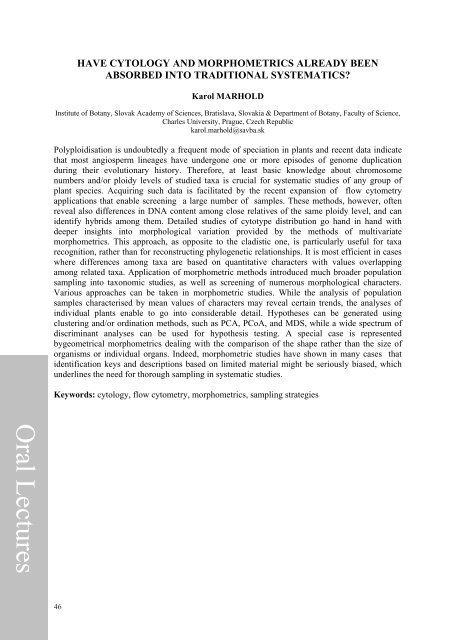Adil GÜNER, Vehbi ESER - optima
Adil GÜNER, Vehbi ESER - optima
Adil GÜNER, Vehbi ESER - optima
You also want an ePaper? Increase the reach of your titles
YUMPU automatically turns print PDFs into web optimized ePapers that Google loves.
Oral Lectures<br />
46<br />
HAVE CYTOLOGY AND MORPHOMETRICS ALREADY BEEN<br />
ABSORBED INTO TRADITIONAL SYSTEMATICS?<br />
Karol MARHOLD<br />
Institute of Botany, Slovak Academy of Sciences, Bratislava, Slovakia & Department of Botany, Faculty of Science,<br />
Charles University, Prague, Czech Republic<br />
karol.marhold@savba.sk<br />
Polyploidisation is undoubtedly a frequent mode of speciation in plants and recent data indicate<br />
that most angiosperm lineages have undergone one or more episodes of genome duplication<br />
during their evolutionary history. Therefore, at least basic knowledge about chromosome<br />
numbers and/or ploidy levels of studied taxa is crucial for systematic studies of any group of<br />
plant species. Acquiring such data is facilitated by the recent expansion of flow cytometry<br />
applications that enable screening a large number of samples. These methods, however, often<br />
reveal also differences in DNA content among close relatives of the same ploidy level, and can<br />
identify hybrids among them. Detailed studies of cytotype distribution go hand in hand with<br />
deeper insights into morphological variation provided by the methods of multivariate<br />
morphometrics. This approach, as opposite to the cladistic one, is particularly useful for taxa<br />
recognition, rather than for reconstructing phylogenetic relationships. It is most efficient in cases<br />
where differences among taxa are based on quantitative characters with values overlapping<br />
among related taxa. Application of morphometric methods introduced much broader population<br />
sampling into taxonomic studies, as well as screening of numerous morphological characters.<br />
Various approaches can be taken in morphometric studies. While the analysis of population<br />
samples characterised by mean values of characters may reveal certain trends, the analyses of<br />
individual plants enable to go into considerable detail. Hypotheses can be generated using<br />
clustering and/or ordination methods, such as PCA, PCoA, and MDS, while a wide spectrum of<br />
discriminant analyses can be used for hypothesis testing. A special case is represented<br />
bygeometrical morphometrics dealing with the comparison of the shape rather than the size of<br />
organisms or individual organs. Indeed, morphometric studies have shown in many cases that<br />
identification keys and descriptions based on limited material might be seriously biased, which<br />
underlines the need for thorough sampling in systematic studies.<br />
Keywords: cytology, flow cytometry, morphometrics, sampling strategies<br />
34






